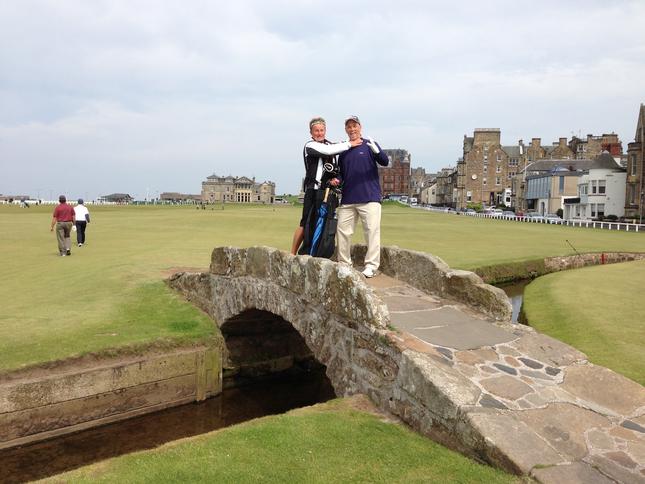Wandergolf
By • April 11, 2014 0 2630

My arrivals to Scotland’s heralded eighteen hole tracts located within the towns of Carnoustie and St. Andrews could not have been more different. When I pulled into the diagonally striped, beach-adjacent parking lot of Carnoustie Golf Links, I could have been arriving at Cape Henlopen State Park in Delaware. The simplicity of the clubhouse serving the Burnside, Buddon, and the Championship Links course that made Sergio cry and Padraig fly reminded me of a friendly ranger station somewhere in the Midwest. Post-play building renovations I could suggest might include signs saying things about entrants abandoning hope or devils appearing in sheep’s clothing.
I played the tamer Burnside course before tackling the beast, and I truly enjoyed the round. Burnside was the course Ben Hogan qualified on in 1953, before winning the Open on the Championship Links. The two Scot members I was paired with were a retired police officer and civil servant, and they played the golf ambassador roles consummately, not withstanding my barrage of questions. The biggest problem for me on these courses was the ever-present, daunting, howling, massive amount of wind. Teeing off on the 460 yard #4 hole “South America” maybe felt like sticking your head out the window of a moving car and trying to spit a watermelon seed on to the hood. One of the ambassadors explained that in order to survive these conditions on the course you have to hit the ball below the wind and that the harder ground will allow low trajectory shots like this to travel a long way. I felt like a pitcher might feel who throws only fastballs being exposed to major league hitters for the first time and realizing he has to learn some junk to survive. The necessity of shaping shots to overcome the elements, probably the very heart of the game of golf, really rooted itself in me on this trip.
One thing I like to tell other golfers to do when golf balls start to go sideways (and never do myself) is to put away the scorecard and just enjoy the day. I actually did this on the Championship Course, not even cheating by keeping the score in my head. It made the par on “Hogan’s Alley” #6 hole a pleasant surprise, the famous spectacle bunkers on #14 more fun to examine, and allowed me to get out of myself enough to imagine what it would have been like to be Van De Velde and blow the three shot lead on the 18th hole in the 1999 Open.
The arrival at St. Andrews was more like arriving at a sports arena, with the prices of the famous Old Course golf shirts going down the further you got from stadium row. Since it is also home to the third oldest English-speaking university in the world, dating back to the 1400s, the American feel to it might be like Charlottesville. Throw a bit of Duke University into the mix, due to the presence of St. Andrews Cathedral, and presto: you have the town that introduced the game of golf to the world over 600 years ago.
Without planning a year in advance, winning a last-minute ballot entry, or being part of a very expensive full service golf tour package, the only way to get a tee time on the Old Course is to walk on the morning you wish to play and ask the starter. It might seem risky but if you are alone and show up early the odds are that the starter will be able to fit you in. How we, as a country, seem to have made our best golf courses aloof, I view as somewhat depressing, when compared to the Scottish community’s pride in making its golf courses accessible to golfers of almost all levels. One of the best comments I heard on this trip came from one of the golf ambassadors I played with at Carnoustie when he pointed to a woman strolling nearby on the course and said, “Wally, that woman walking her dog over there. She may not play golf, but this is her course, too.”
I spent the time waiting to tee off on the Old Course listening to priceless stories from famed Starter, Rod Sturrock. Part of his humble duties as gatekeeper to the most famous golf course in the world include standing quietly behind golfers teeing off, as a significant number of golfers that have traveled from far and wide to this golf mecca get wobbly kneed and pass out on the tee box. Laughing out loud at the expense of other golfer’s exploits at the famous links course was sure to have been what caused me to duff my tee shot, but I still managed to bogey the first hole.
My caddie at St. Andrews, Neil Crate, was the only caddie I have ever had that threatened me for potentially failing to execute golf shots. His threats and humor coerced me out of the “Bobby Jones” bunker on 13 in one shot, guided me away from “Hell” on the 14th hole, delivered me past the “Valley of Sin” below the 18th green, and on to hole out for my best round of the trip.
The levity with which I approached the round pegged me as the target for the exploding golf ball routine the caddies occasionally trot out. I even met Oliver Horovitz, author of “An American Caddie at St. Andrews,” an amusing coming of age memoir, written by a Harvard student about “Growing up, Girls, and Looping the Old Course”.
While not scheduled to play them, I managed to get in rounds at the Jubilee and Castle Courses at St. Andrews also. They were picturesque, and the time spent there worthwhile. Since this was my first trip to Ireland and Scotland and was a family adventure, golf was not the only agenda, but it could have been. I ogled castles, kissed the Blarney Stone, black-taxied through Belfast and bought sweaters in Edinburgh, but destinations like Old Head, Royal Dornach, and Ballybunion will ensure my return to the area of the world that spawned the game of golf.
Wandergolf will be a frequently appearing golf column in The Georgetowner that will be reporting on the golf interests of Washingtonians. If you have suggestions for columns or comments, please email them to wally@wandergolf.com
- Caddie Neil Crate strangling Wally at the Swilcan Bridge on 18th of St Andrews. | Wally Greeves




